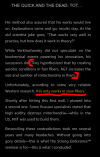ali
Level 7 Valued Member
Difficult to unpack, but also probably irrelevant if you're doing all of this for health outcomes, as opposed to winning the Tour de France.
Agree but the goalposts constantly shift with zone 2.
A health must do....it isn't. Performance enhancer....it depends. Longevity....iffy.
This when compared to generally being active eg walking a lot and/or strength training and intervals.
The pre diabetic state of excessive endurance training in cyclists with evidence also of reduced telomere length, a supposed sign of increased biological age is not the state most other recreational athletes find themselves in.
This is the excessive endurance analogue to the daily constant thrashing of tabata Cross fit wods and for many strength focused athletes this is more of a risk than excess endurance volume...leading to a negative health outcome.
From sedentary to excessive, for health stay in the middle-ish somewhere. Do zone 2 if you want but it isn't the holy grail unless you want to emphasise it for an event training.
2/3 days a week zone 2, 2/3 days of strength. Great.
Daily walking, 2/3 strength days, 2/3 days intervals. Great too.
1 day zone 2. 1 day intervals. I day max strength. Plus 1 optional day of preference. Great aswell (Andy Galpin recommendation).
4/5 days zone 2. 1 day strength. Great for an endurance athlete only. For health v all the above?
I'd argue inferior but some endurance bias spin may argue otherwise.


